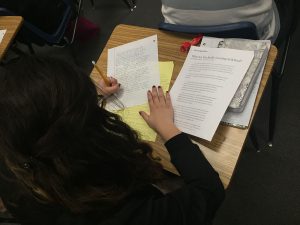By Rosa Cesareo

Graphology, the study of handwriting, tells much more about a person beyond what they write. What does script say about character? Research by the National Pen Company reveals that penmanship indicates over 5,000 personality traits.
Small versus large lettering tells whether a person is shy and quiet or outspoken and social. Adaptable people tend to write in an “average” size. Wider spacing between words matches a person’s character as one who doesn’t like being overwhelmed or crowded, while narrow gaps suggest a fear of being alone and desire for human contact.
“I like to think that I am a person who is very relaxed and free, and I hate feeling surrounded.” Arya Ziai, sophomore, said. “I like my own personal space. I write with wide spacing between each word, so it makes sense.”
The slanting of letters suggests various characteristics as well: slanted right text correlates to open-mindedness while introverted, possibly rebellious individuals, tend to write slanted left. No slant implies a logical and practical mindset.
“When I write, my letters have no slant,” Gia Morris, sophomore, said. “They are also rounded with narrow spacing.”
Those who jot down rounded letters are more creative and artistic compared to the intelligent and intense people who express themselves with pointed letters. Connected letters or cursive means that one is systematic and makes decisions after careful thought. Committed people apply heavy pressure with their writing materials; in fact, excessive heaviness may imply that a person is uptight or easily offended by criticism. Lighter pressure demonstrates delicacy yet also a lack of liveliness.
“When I write, I apply light pressure, but I don’t necessarily consider myself to be delicate or sensitive,” Taieem Comeaux, junior, said. “But, I am definitely sensitive for others- I care about people.”
Besides being an indicator of character, graphology has scientific purposes including lie detection and diagnosis of health ailments. If a person’s script is more crowded, out of alignment, or varies from the rest of the writing, it is likely that he or she has lied. Telltale features such as irregular, inconsistent handwriting correlate to health problems including high blood pressure, Alzheimer’s disease, schizophrenia, and Parkinson’s disease.
“I’ve always thought that some handwritings were prettier than others, but I never knew that it could be so interesting,” Ziai said. “The fact that there are so many uses for it is really fascinating.”











